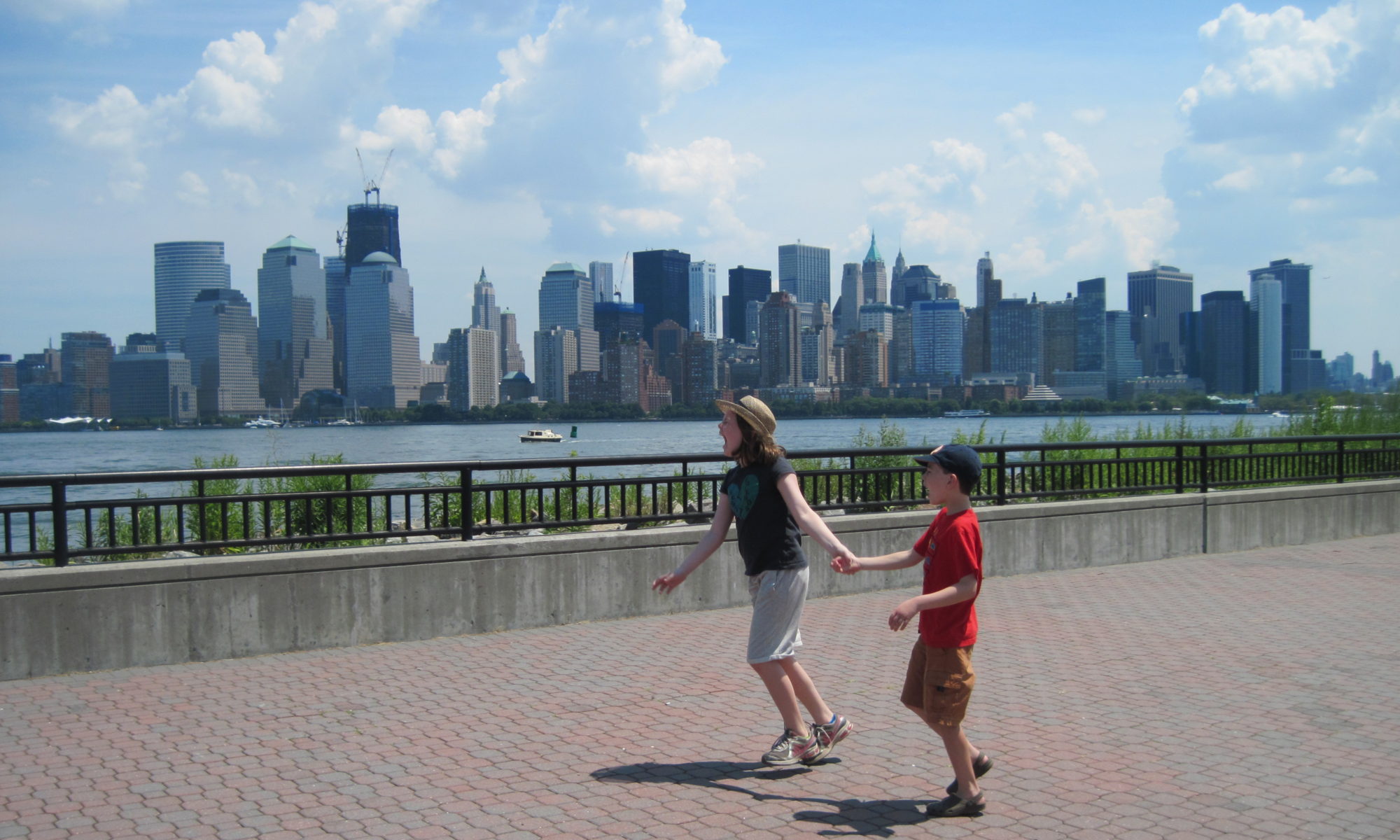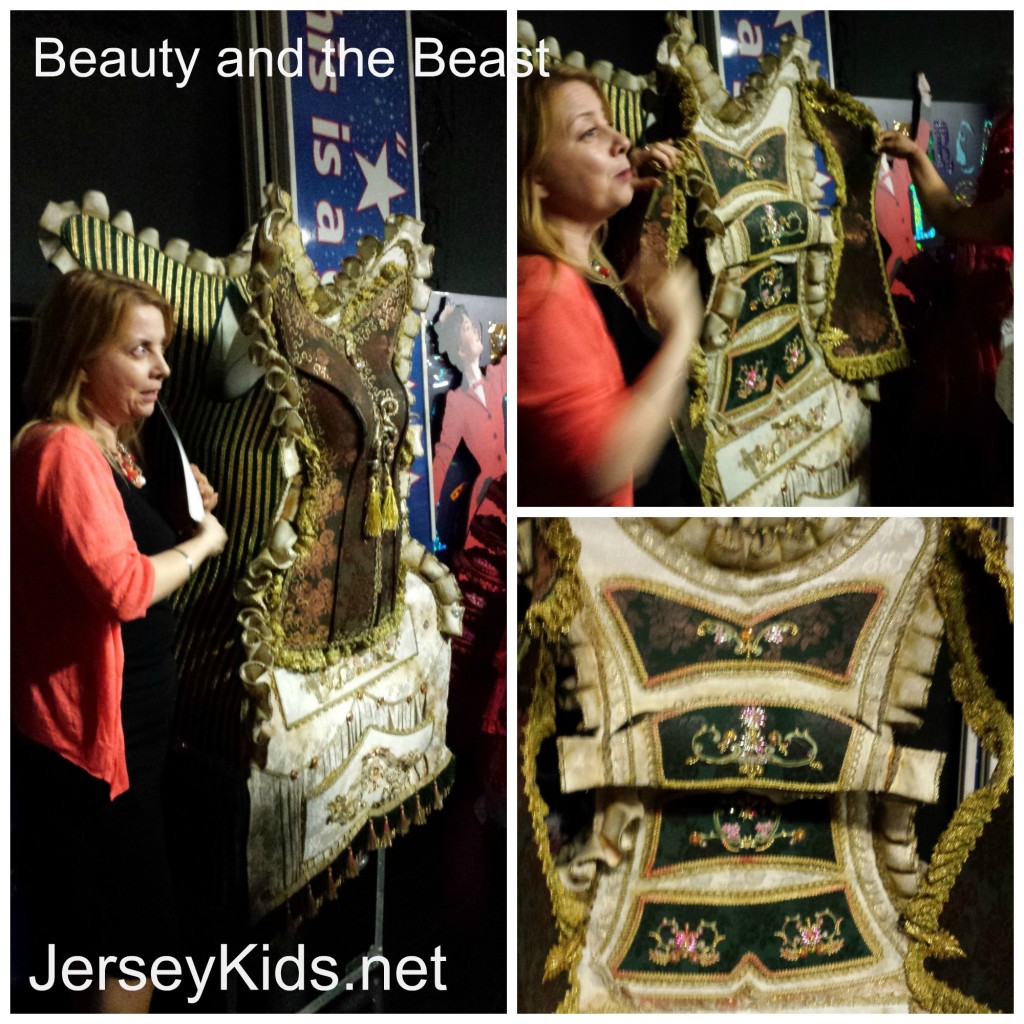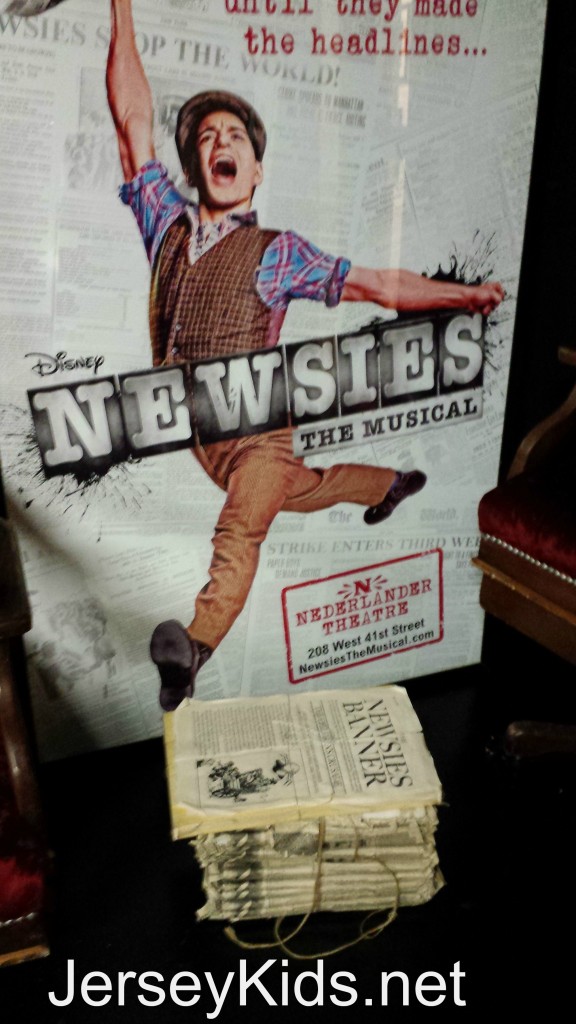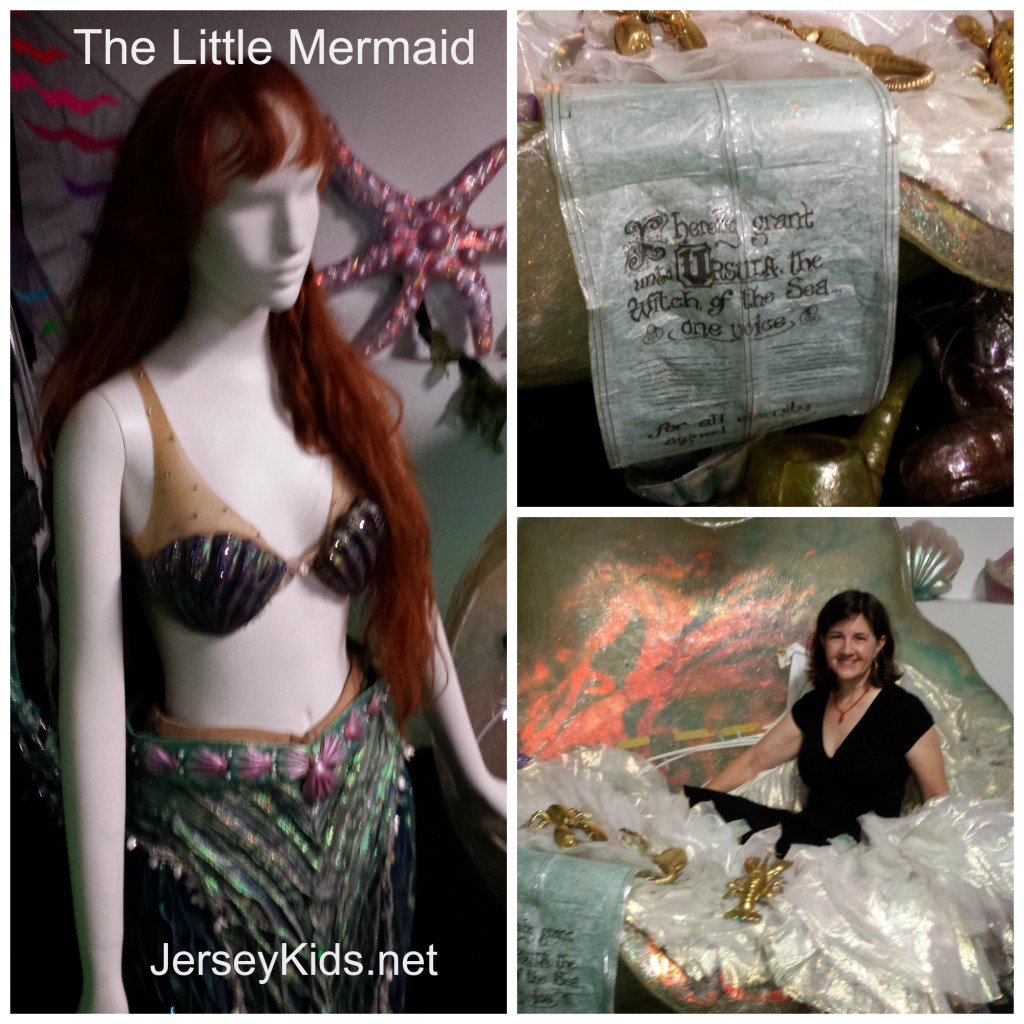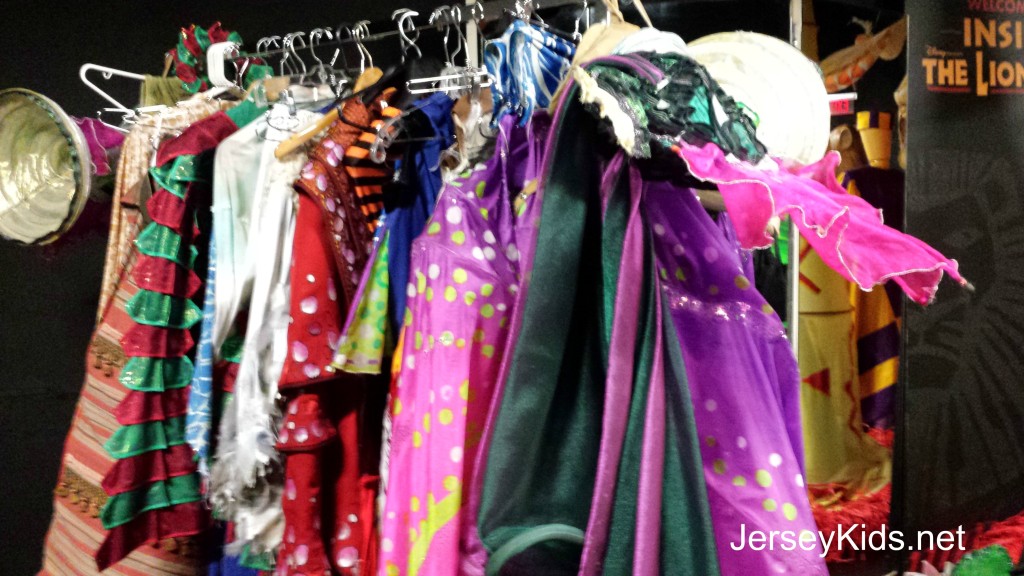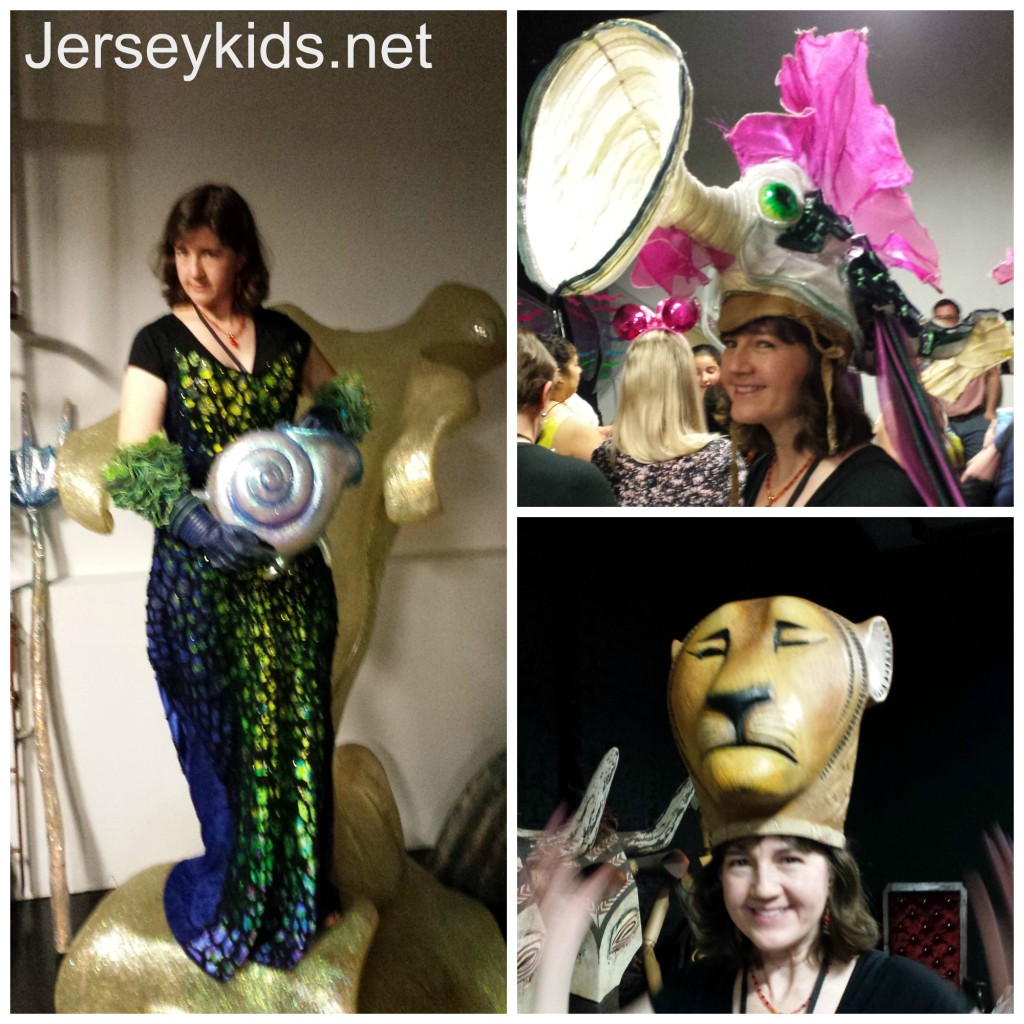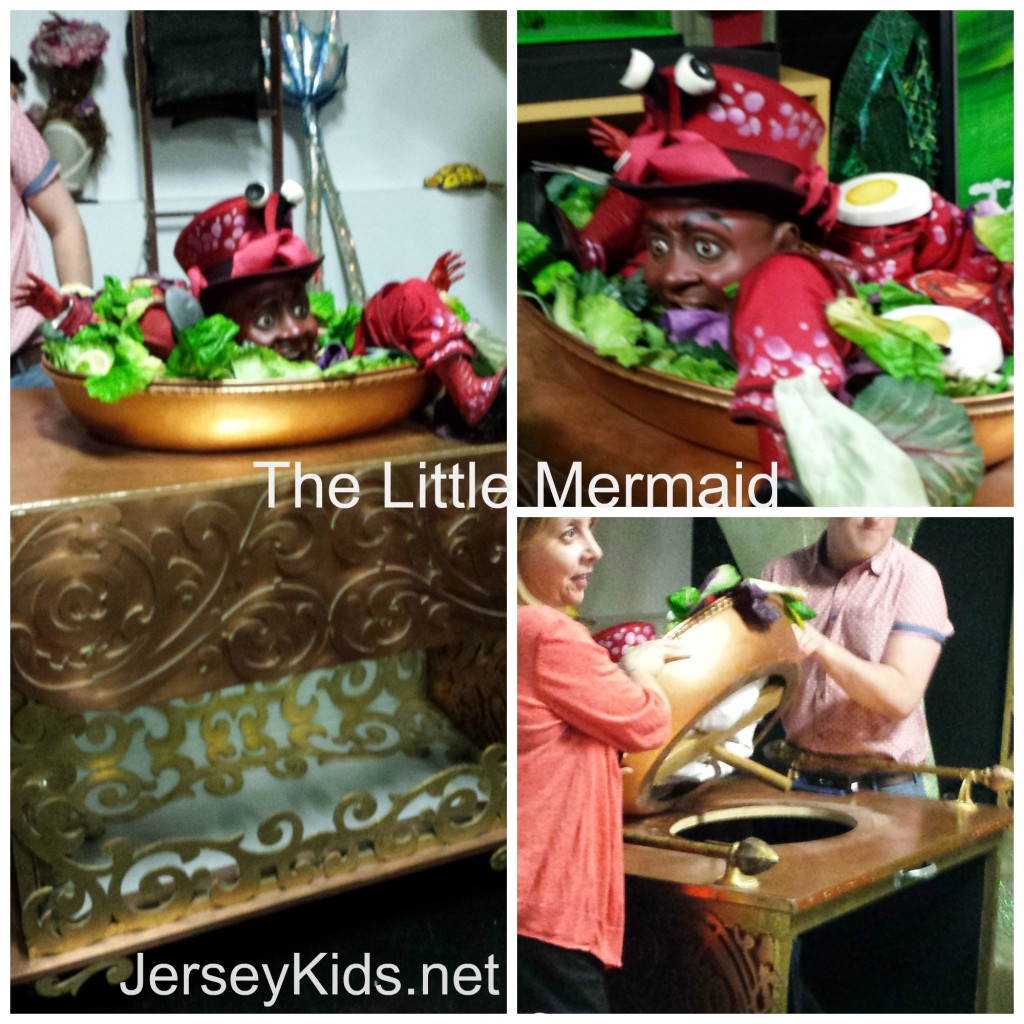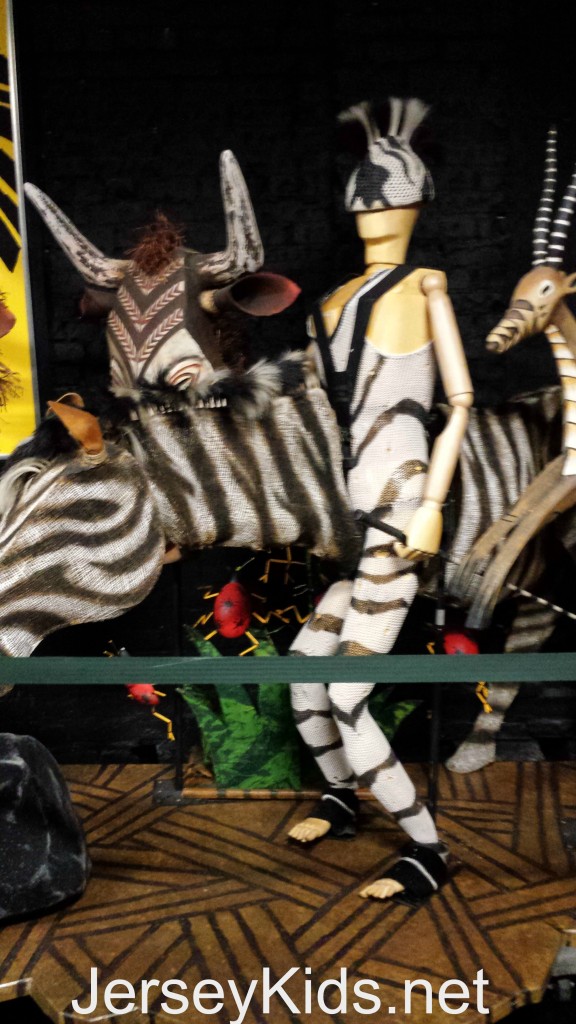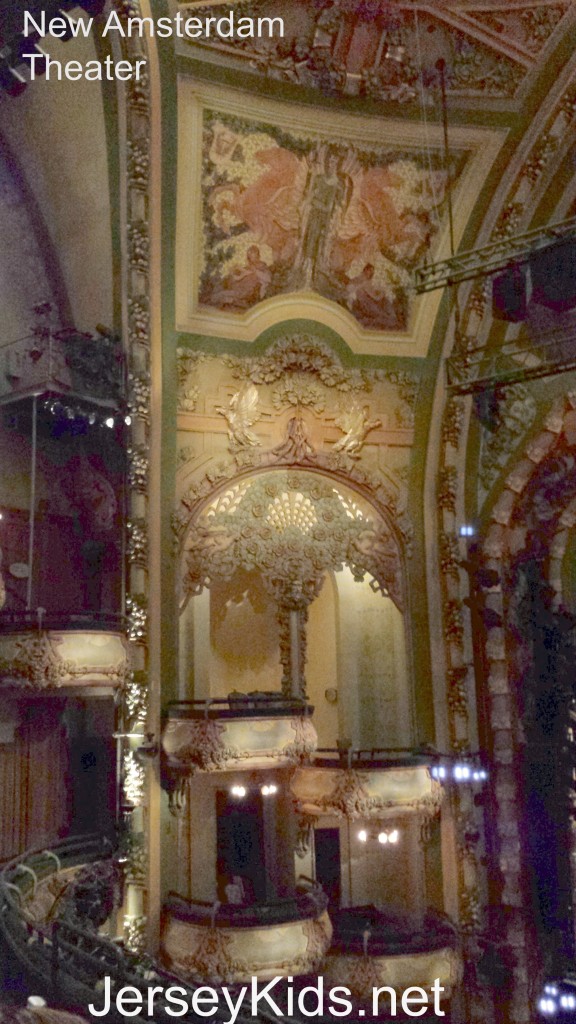If you’re a regular reader of this blog, you’ll see I’m a big Broadway fan (see our reviews of Broadway shows and our family friendly Broadway show page: Broadway for kids). So I was super psyched at a recent Disney Social Media Moms On the Road conference to get the “Behind the Magic” tour at the New Amsterdam Theater.
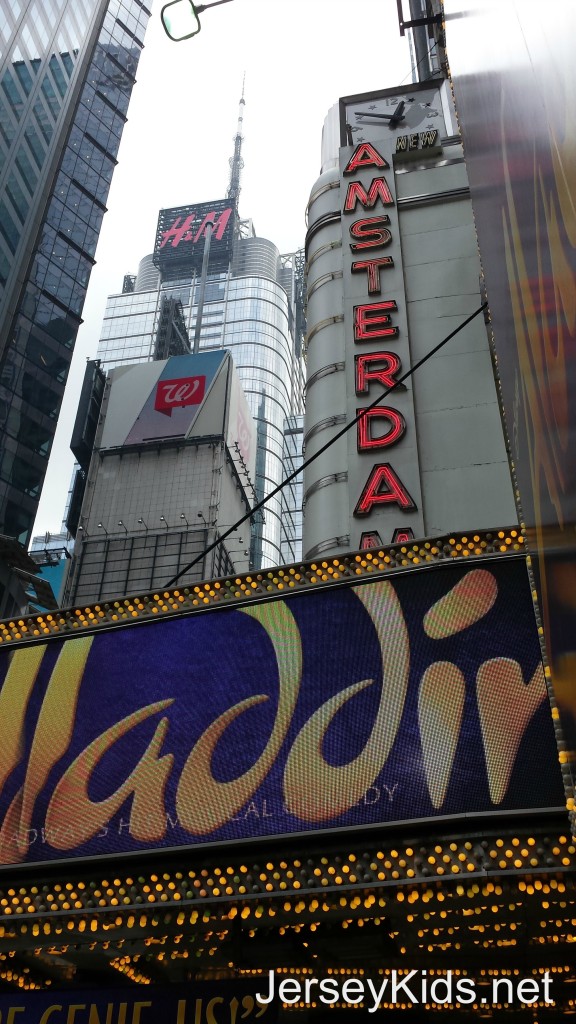
This tour is open to the public to those with or without Disney Broadway tickets
The tour is divided up into two parts, the props room and the actual theater. We’ll start with the props room, which as you might imagine contains actual props and costumes from Disney Broadway productions including Beauty and the Beast, Aida, Tarzan, Mary Poppins, the Lion King, Newsies and the Little Mermaid. And you can actually try on the costumes!

The first stop in the room was to see the rose from Beauty and the Beast. We also saw one of the Beast’s boots, which looked like a big, old leather boot, with hairy toes. It opens with not-so-old fashioned Velcro. Our guide said that to keep the boot comfortable for the actor, it’s actually built around a Reebok sneaker, though of course that is hidden inside!
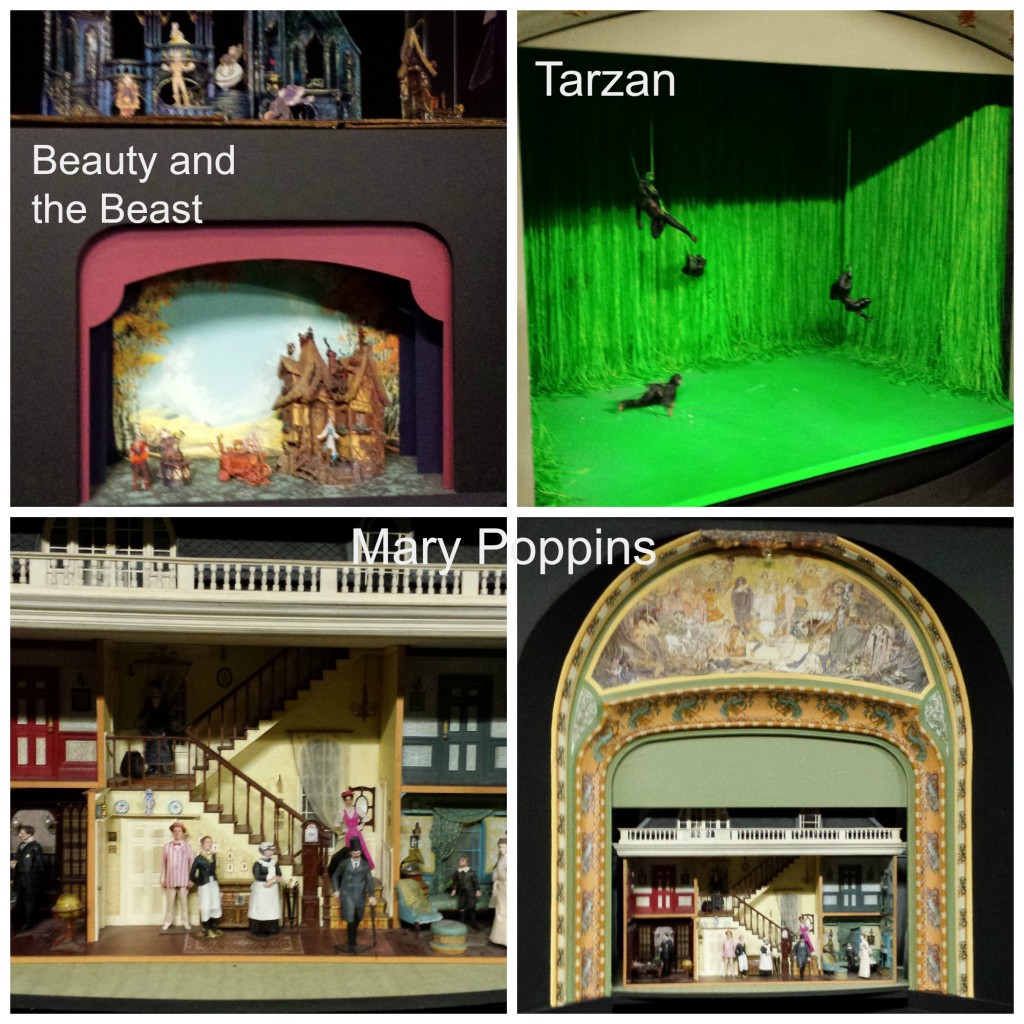
They also had a small “mockette” for Beauty and the Beast (not sure if I spelled that right), which is a miniature version of the Broadway set, including paint colors. These are created to help the other designers do their jobs, like for lighting and costumes. The designers will look at the mockette to see the colors to be used, which helps them coordinate and plan. We also saw the mockettes for Mary Poppins and Tarzan.
Speaking of Velcro…the costume above is the one worn in Beauty and the Beast, the lady-in-waiting who turns into the Wardrobe (Madame de la Grande Bouche). To get into this massive costume, the actress steps in from the side and I think it Velcros shut. You can see the fancy bodice in the above left picture. When it’s time for her to turn into the Wardrobe, you can rip it open because of the Velcro attachment, revealing the chest of drawers inside. One of the drawers actually opens, and it holds some of jewels or coins that are scattered about later. The whole thing lights up as well (we saw a photo of that).
[ad name=”Google Adsense-1″]
We saw the chairs and a stack of newspapers from Newsies. The chairs are the ones in Mr. Pulitzer’s office, and you can sit on them. I didn’t do that, however they did look quite comfortable!
The Little Mermaid had a ton of props. I saw this show at Paper Mill Playhouse in New Jersey a few years back. You can see Ariel’s costume above left, and the bathtub she sits in when she turns into a human. It’s fiberglass and has a glass seat inside that I’m resting my tush on. It’s quite large (the bathtub, not my tush) and it’s filled with a lot of crinkly stuff, topped with gold lobsters. There’s also a scroll giving Ursula a voice.
Almost all the costumes you can try on are from the Little Mermaid – you can choose anything from the rack above. Below you can see me dressed as Ursula. I thought Ursula was supposed to be fat, but the costume was pretty snug and I’m not fat by any means (I’m wearing my own dress underneath the costume). The shell I’m holding is where Urusula captures the voice. It has a microphone system inside, to capture the voice, but there was no battery pack in there. Probably a wise move! I’m standing on King Tritan’s throne.
We got to try on masks from the Lion King. I didn’t realize that the Lion King story is basically Hamlet, but with animals. Our guide showed us the Lion mask, with the circle of life worked into it – it’s balanced and rounded. Scar’s mask has no symmetry and harsh angles. It’s not balanced with nature. Good = balanced. Bad = nonsymmetrical. There you go!
Each mask has a custom fit for the actor. When hired, the actor gets his head set in plaster to make the mask. I’m not sure why, since the inside is also outfitted with the plastic sizing bracket that you’ll find in a construction hat, because that’s where it came from. The masks were initially clay, but that was super heavy. These are carbon graphite, but look like carved wood. They weigh only four ounces! We were supposed to keep two hands on the masks at all times because they cost $7,000 each! I got yelled out for taking my hands off the mask for this picture. Oops. Sorry!
Okay, back to the Little Mermaid – this show had the most props in the room. They had this nifty cart that’s used when Sebastian is almost cooked for dinner. You can see the guy in the salad above left. The cart is magical. There’s actually someone hiding behind the cart – it’s trick imagery in front. It looks like it goes all the way back, but really there’s room for someone to hide in the back. The front is actually slanted, with a mirror in there, so it looks whole. The guy behind the cart can’t be seen when wheeling it out, and then he pops the salad bowl/head up with a stick for great comedic effect.
Okay, now we’re back to trying on costumes. The above left one is from the Little Mermaid – not sure what character, but the dress is her own. On the right, of course, is Mary Poppins. Unfortunately I ran out of time to try that one on. The costume below was display only!
After the props room, we went into the theater itself. This is the oldest working theater on Broadway, built from 1901-03. It’s built in an art nouveau style. It’s the only public space (not sure if it’s in the U.S. or the world) with this degree of art nouveau styling. Art nouveau is based in the natural world, here that’s carried out with vines, flowers and a leaf motif. The style also calls for curvilinear space, which you’ll see throughout the entire theater, aside from the walls (which have some columns and are straight in some areas). Even the box seating area is rounded.
The stage area has eight floors above the stage and three floors below to work with.
This was a very expensive theater to build. The estimated cost to build was initially $750,000 in 1901, but the actual price to build doubled. In today’s costs, it would be $40 estimated to $80 million actual building cost.
The theater is designed to look like a garden at twilight, so it was appropriate (perhaps planned this way) to premier a Midsummer Night’s Dream as the first show. The show bombed, open for only 26 performances, but the theater itself got rave reviews, the New York Times nicknaming it “house beautiful.” It took 10 years for the theater to have a hit performance, and that came in 1913, the Zigfield Follies. It stayed at the New Amsterdam Theater until 1927, when Zigfield moved the Follies to his own theater.
The Follies was a review show (no plot, just showstopping numbers). Zigfield spared no expense, spending $4,000 (in 1920s money) for petticoats, with the idea that if the performers felt like a million bucks, they’d act that way too. He hired leading fashion designers to make the costumes, and leading architects to design the sets.
The main theater has 1,700 seats, and surprisingly, there’s another theater upstairs, on the 7th and 8th floors. That theater held 700 seats. The upstairs theater’s back wall is the same space as the proscenium for the downstairs (the front curtain area, basically). While they couldn’t run performances at the same time due to noise issues, they had a family-friendly performance downstairs during the day, and an adult show at night, the Midnight Frolics, which was so racy that the performers would expose their shoulders and ankles! They installed a glass walkway from the stage to the seating area, and they charged more to sit near and under the walkway. Sitting below, you could sort of see up the dresses of the performances, not that there’s much to see with huge petticoats. They introduced the show at 5 cents a ticket, and it was so popular that it rose to $5 a ticket within a month, the equipvalent of $500 now.

When in the main theater if sitting in part of the orchestra section or first balcony, you can look up and see some women flush to the ceiling, that weigh 500 pounds and are 12 feet long each. The other theater is above them. The picture below is highly amplified, and there are bright lights next to them. They’re kind of hard to see unless you’re looking for them.

The Great Depression hit Broadway hard, and wiped out two-thirds of the Broadway theaters. Many of the buildings turned into movie theaters and radio studios. The New Amsterdam turned into a movie theater, and in 1937, the first movie they showed was…A Midsummer Night’s Dream, film version. The movie theater stayed open until 1982, converting to a Cinemascope theater with a wider projection screen. Because the screen extended so far widely, patrons complained that the box seats cast shadows on the screen. So the owner ripped the boxes off and trashed them. Then patrons complained of a glare on the screen from the sides, so in order to satisfy patron complaints and avoid giving ticket refunds, the owner then painted the side box areas chocolate brown. But if you look at the gorgeous paintings on the interior now, it’s painful to imagine them being painted over.
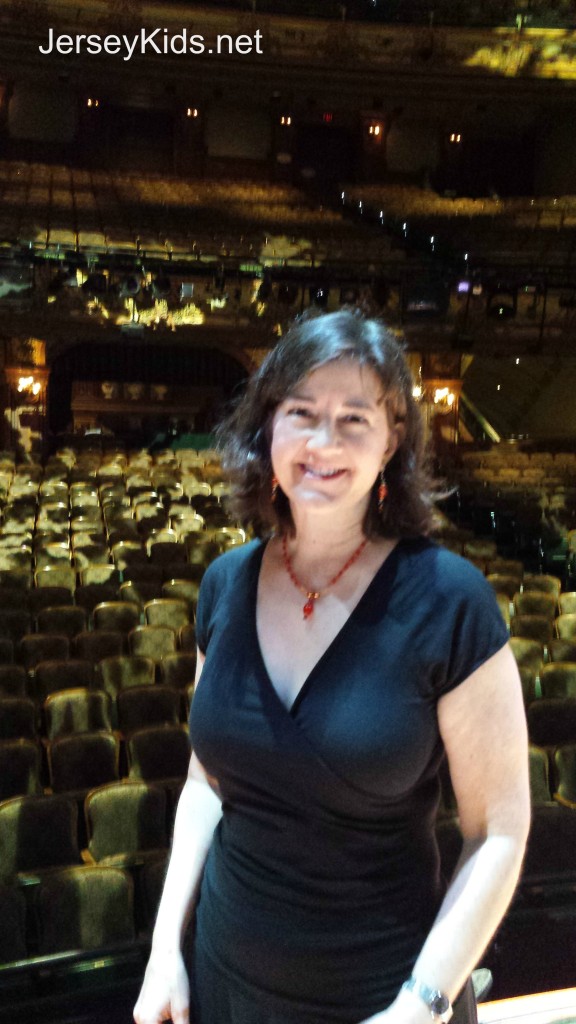
That’s me above, standing on the stage of the Lion King with my back to the audience (don’t ever have your back to the audience on stage!). On the Behind the Magic tour, you will not be able to go on stage, nor to see the Aladdin props we saw behind the stage and on the side. I wasn’t allowed to take pictures of those. It was pretty amazing to go on the stage though!
Okay, back to the history. In the 1960’s and 1970’s, this became the premier Kung Fu movie palace. At the time, 42nd Street was a dangerous block. In the early 80’s, there were 2,300 crimes on this block alone in one year. The block was filled with X-rated movies, peep shows and hookers. A “crowded” theater would be 12 people – and many of them were using the theater a a place to get out of the rain and get some sleep. The owner wasn’t making any money and decided to convert the building into a parking garage. Concerned citizens got the NYC Landmarks Commission involved, and it was designated as a historic building, inside and out. This was bad news for the owner who now needed permission to make any changes. Instead of making roof repairs, he put tarps on the roof, which still let in rain and snow. In 1982, he called it quits, locked the building up and abandoned it. The city later foreclosed on the building because of unpaid taxes, and it remained closed until 1994.
The building continued to sustain damage from the elements. When it rained outside, it rained inside. At this time Mayor Giuliani was trying to revitalize 42nd Street and approached any company he could find that might be willing to take a chance on it. He finally spoke with Michael Eisner of Disney, whose small Disney Theatrical Productions was a small business.They were staging staged Beauty and the Beast in Texas, and Eisner finally agreed to take a look at the building.
When he came, Giuliani was unable to open the metal gate more than 2.5 feet off the ground, and he and Eisner eventually decided to crawl underneath to get inside.

Inside they found an ecosystem, with mushrooms (caps the size of dinner plates), a tree in the orchestra pit, cats and cockroaches and other animals/vermin. Eisner agreed to restore the building, but decided to open Beauty and the Beast elsewhere as renovations were made. It took 18 months and $36 million to restore it, and they did an “interpretive” restoration, meaning that there are elements from several different architectural eras. The balustrades are green terra cotta (pictured above), and those are original and unrestored.
Initially the building had one toilet for women (it was unfashionable for ladies to use the restroom in public in the early days of the theater). Fortunately that changed, and they built 26 toilets for ladies, adding four more a few years later. They believe this is the highest ratio of restrooms per female patron on Broadway. Instead of bringing a big show on to start, they had two limited engagements to test the theater. Then they brought on the Lion King and then moved the Lion King, and brought in Mary Poppins (we saw Mary Poppins in this theater probably in 2010). When Mary Poppins closed in 2013, they closed the theater for a year for some additional restorations (that’s when they added the extra restrooms). Aladdin opened in March, 2014 and is still playing today.
About the upstairs, it had been used as rehearsal space at one time. Gypsy was written in that upstairs space (it’s a great show – saw that on Broadway with Patty Lupone). At one point in the 1970’s, they drew the winning ticket for the New York lottery up there. Now it’s office space, used by the Disney Theatrical Productions.
If you go:
How can you go on the Behind the Magic tour?
The cost is $25/person if you are not booking a Disney show as a group. The cost is $20/person if you’re seeing a Disney show and you’ve booked it already. I got some conflicting accounts about the minimum number for a tour. Our tour guide said it was 10. When I called the Disney Theatrical Productions sales office number, they said 15. The website seems to say 20, but maybe they mean that you need 20 people to get group tickets for a show. The tour guide said that if you have fewer people in your group, you can just pay for the minimum number – they don’t care how few actually show up. In any case, call them for details. Tours are an hour and generally run at 9, 10 and 11 a.m. daily.
You can request details on the Disney Theatrical Productions website, or call 800-439-9000. You won’t find details about the tour on the web.
Thank you to Disney Social Media Moms Celebration and Disney Theatrical Productions for hosting us on the tour.
